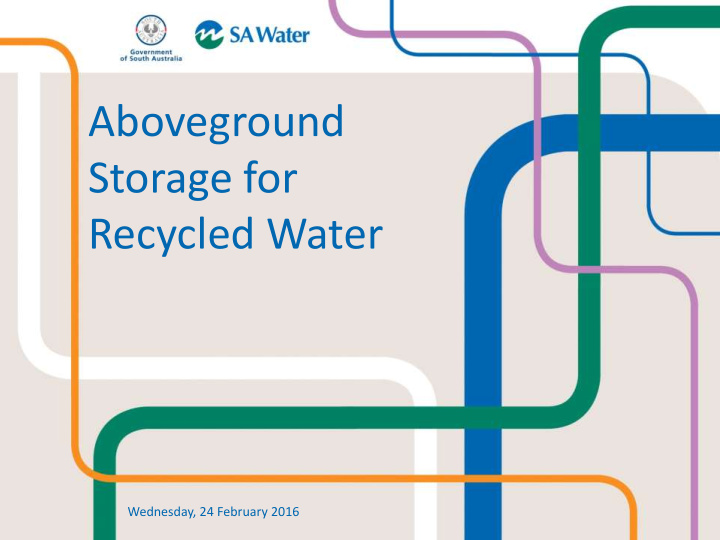



Aboveground Storage for Recycled Water Wednesday, 24 February 2016
What are the options? • Reservoir – Need useful geography • Tanks – Limited size – High cost/volume ratio compared to other methods • Lagoons – Covered or uncovered – Simple construction – Holds large volumes Page 2 24/02/16
Storage Lagoons: Construction Page 3 24/02/16
Site selection and survey • Check site geology • Check for site contamination • Planning approval Minnipa Page 4 8/03/2016
Excavating topsoil stockpiling • Top soil stripping • Site preparation Aldinga Page 5 8/03/2016
Excavating Aldinga Page 6 8/03/2016
Excavating Aldinga Page 7 8/03/2016
Use excavated fill to Excavating build embankment Aldinga Page 8 8/03/2016
Compaction Minnipa Page 9 8/03/2016
Embankment roads Page 10 8/03/2016
Connect pipework Aldinga Page 11 8/03/2016
Rock Lined Lagoon • Geotextile fabric membrane • 300mm minimum layer of blast rock • Monitoring wells placed around lagoon
Membrane Liner Minnipa
Underdrain – leak detection Page 14 8/03/2016
Liner anchor points Minnipa
Cover Minnipa
Cover Minnipa
Aldinga
Storage Lagoons: What are the advantages and drawbacks? Page 19 24/02/16
Advantages • Relatively simple construction • Inexpensive materials
Advantages • Extensive industry experience with dams and lagoon management
Advantages Water coming in • Network balancing storage – Assists in maintaining pressures and flow during irrigation season Water going out Time
Advantages • Leak protection – Clay liner or membrane keeps water in place • Certainty of available water – Easily calculated and monitored
Drawbacks • Large area required – Purchase and availability of land – Site cannot be used for growing crops – Likely to need several storages – Algae 800ML Storage 7ha 13m deep (5m underground)
How do the numbers stack up? Drawbacks 50 1,200,000 Area of lagoon (ha) Balance of fill (m3) 1,000,000 40 800,000 • Depth limited by shallow 2m 30 600,000 groundwater levels 400,000 20 1m • Disposal or import of fill 200,000 10 - 0 -200,000 2 3 4 5 6 Total depth of storage (m) 1GL 4m deep approx 25ha (including embankments)
Drawbacks • Pests – Risk of large midge populations – If lagoons are close then infestation spreads easily – May need chemical control
Drawbacks • Weeds and reeds 31/12/2004 03/08/2005 26/04/2006 18/02/2010 27/09/2013 31/12/2014 27/01/2015 09/10/2015
Drawbacks • Water quantity and quality issues – Reduction in volumes available and increasing salinity due to evaporation – Salinity may restrict irrigation of some crops or require desalination 30 1000 Rainfall and evaporation (mm/day) Lagoon volume (kL) 25 800 Evaporation 20 600 Rainfall 15 Lagoon volume 400 10 200 5 0 0 (Image credit: wplynn, link)
Drawbacks • Water quality issues – Contamination from birds – May require post storage treatment
Drawbacks • Water quality issues – Algal growth during irrigation season, shown to impact pH balance – Likely to require post storage treatment – Storage may need to be covered, adds to cost and maintenance
Drawbacks • Controlled access and safety – Large fences to control access – Structures for safe operation and maintenance
Summary – Aboveground Storage Advantages Drawbacks Relatively simple construction Large area required Inexpensive materials Shallow groundwater limits depth Extensive industry experience with Fill needs to be removed or imported dams and lagoon management Leak protection – easy to identify problems Pests – midges and vegetation Network balancing storage Evaporation reduces volumes available and increases salinity Certainty of available water Algae affects quality of water and may impact pH Pathogens introduced by birds Covering is costly and may limit the size of lagoon Page 32 24/02/16
Thank you. Questions? Page 33 24/02/16
Recommend
More recommend